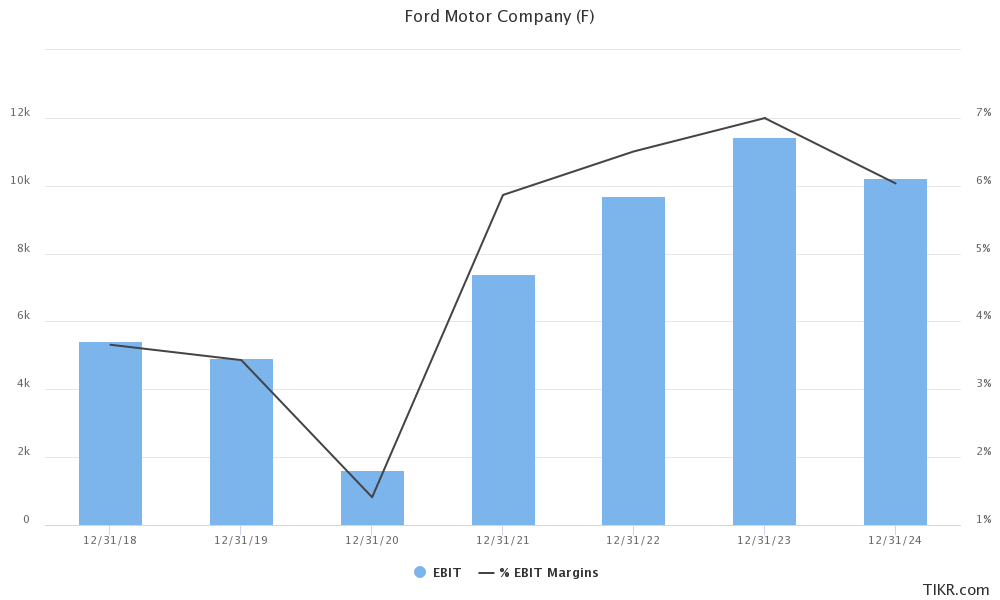Ford Stock Continues to Fall After Q2 2023 Earnings Release
Please note that we are not authorised to provide any investment advice. The content on this page is for information purposes only.
Ford (NYSE: F) stock fell sharply after its Q2 2023 earnings last week. The stock continues to trade on a negative note amid apprehensions over its electric vehicle (EV) business.
To be sure, Ford posted better-than-expected numbers in the second quarter and its revenues were $42.43 billion which was higher than the $40.38 billion that Wall Street expected. The company’s adjusted EPS came in at $0.72 which was also well ahead of the $0.55 that analysts had forecast.
Ford stock fell amid the apprehension over its EV business. Notably, last year Ford became the first legacy automaker to separate the internal combustion (ICE) business from the EV business. While both the businesses along with Ford’s commercial business form part of the company, it reports their earnings separately.
Ford reported a massive increase in EV losses
Ford’s EV business which it renamed Model E lost $1.08 billion in the second quarter which took the segment’s pre-tax losses in the first half of 2023 to $1.8 billion. If that was not all, Ford said that the segment’s losses would expand in the second half and expects full-year pre-tax losses of $4.5 billion – which is significantly ahead of the $3 billion that it previously guided for.
Interestingly, despite higher-than-expected losses in its EV business, Ford raised its full-year pre-tax profit guidance to $11 billion to $12 billion – up from the previous guidance of $9 billion to $11 billion.
Ford expects slower EV adoption
Meanwhile, Ford expects EV adoption to be slower than what it previously envisioned and said that its annual capacity would now hit 600,000 by the end of 2024 instead of this year which it previously expected. It also said that it might not hit the 2 million production capacity by 2026 as “we maintain flexibility on where we reach when we reach two million total EV global capacity because we are balancing growth, profitability, and returns.”
It blamed the EV price war and said, “While EV adoption is still growing, the paradigm has shifted. EV price premiums over internal combustion vehicles fell more than $3,000 in the second quarter and nearly $5,000 in first half. We expect the EV market to remain volatile until the winners and losers shake out.”
EV price war
Notably, Ford has also joined the EV price war, and last month it lowered the prices for its F-150 Lightning which was preceded by a price cut on its Mach E as well.
Ford CEO Jim Farley said, “The near-term pace of EV adoption will be a little slower than expected, which is going to benefit early movers like Ford.”
He added, “EV customers are brand loyal and we’re winning lots of them with our high-volume, first-generation products; we’re making smart investments in capabilities and capacity around the world; and, while others are trying to catch up, we have clean-sheet, next-generation products in advanced development that will blow people away.”
Jefferies downgraded Ford stock
Yesterday, Jefferies downgraded Ford stock from a buy to hold and said, “However sensible it is to slow down the pace of loss-making Gen 1 sales to preserve returns, the change in Model e guidance is a setback just a few weeks after the May 22 Investor Day for a group that has needed to address volatility in operating performance.”
Jefferies analyst Philippe Houchois had upgraded the stock two months back only but downgraded it “with a heavy heart” after the disappointing Model e guidance.
He added, “We appreciate efforts in disclosure and accountability and note no apparent change to mid-term strategy, with Gen 2 focused on software centric and concentrated line-up making sense to us, but effective in ’26 leaving a less differentiated investment case in the interim years.”
Morgan Stanley maintained its overweight rating on Ford
Meanwhile, Morgan Stanley maintained its overweight rating on Ford and said, “Solid 2Q beat and upped FY guide driven by strong margin and cash flows from Blue and Pro.” JPMorgan also raised Ford’s target price from $15 to $16 after the earnings release.
Notably, during the earnings call, Ford said that it would also focus on hybrids. Farley said, “What the customer really likes is when we take a hybrid system that’s more efficient for certain duty cycles and then we add new capabilities because of the batteries.”
The move surprised markets as most other automakers are focusing on EVs. Toyota is a notable exception as the company is focusing on EVs, hybrids, as well as hydrogen vehicles.
EV price war might escalate further
Legacy automakers are ramping up production and both Ford and General Motors are investing billions of dollars to enhance their EV production. Volkswagen has also stepped up its game in the EV space and is targeting a 10% US market share by the end of this decade which is over twice the current share.
EV competition is set to intensify in the coming months which might only escalate the price war. Pricing pressure would meanwhile increase the troubles for startup EV companies that are posting losses.
Tesla has set itself a target of producing 20 million cars annually by 2030. To put that in perspective, Toyota, the world’s largest automaker, sold just over 10 million cars in 2022. Tesla expects to produce around 1.8 million cars in 2023 and said that it has the capacity to produce as many as 2 million cars.
To achieve the goal of 20 million deliveries, which amounts to a CAGR of over 41% between 2023 and 2030, Tesla might need to build many more Gigafactories. In the past, Musk said that the company would need over a dozen Gigafactories to reach that goal.
Currently, it has four plants of which Berlin and Austin, are in the process of ramping up production and it has announced another Gigafactory in Mexico.








